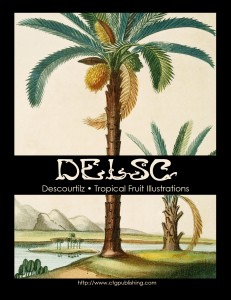M.E. Descourtilz Biography
 Michel Étienne Descourtilz (1775-1835)
Michel Étienne Descourtilz (1775-1835)
Born: 1775 at Pithiviers, France
Died: 1835 at Paris, France
Wife: Daughter of Rossignol-Desdunes
Son: Jean Théodore (1796-1855)
In 1798, Descourtilz left his family in France to travel with his mother-in-law to Haiti, according to Girard, in order to “recover the valuable plantations held by his Creole relatives.” This historic time in Haiti was recorded by Descourtilz through his natural history collections and memoires. What you see in the two delsc editions are what saved his life.
According to Descourtilz in his Voyages d’un naturaliste, the commander Léandres assassinated the Rossignol-Desdunes family. He barely escaped the massacre but recognized his luck and a few major figures. The first is Madame Dessalines who, through her tenderness, convinced her husband to spare Descourtilz. The second is Thouvenot.
Make no mistake that Descourtilz was a prisoner of Dessalines. He did manage to escape during a battle. It is General Pierre Thouvenot who enabled him to find a safe passage back to France to preserve his artistic works. It was just as the canon announced the departure of the ship, La Torche, that the port was set ablaze, engulfing much of his works of art and natural history. He remained in France as a physician, writer and active member of many scientific communities, serving as the President of the Linnean Society of Paris.
Two editions of deslc are dedicated to the botanical prints as printed in Flore pittoresque et médicale des Antilles [short title]. The illustrations were painted by Michel Étienne Descourtilz’ son Jean Théodore (1796-1855) from the drawings and directions of his father. The below is an excerpt from the work that gives the reader a glimpse into this period in history.
Excerpt from Flore pittoresque et médicale des Antilles
“With the intent to extend the usefulness of this work, in favor of the needs of the colonists to whom it is most particularly intended, I joined, as much as possible, to the Latin names, the common French and Caribbean names. It is therefore physically impossible, by means of the botanical details and especially the drawings created by myself based on nature, reduced before my eyes and painted with the greatest care by my son [Theodore Descourtilz], student of the celebrated Wanspaendonck, not to recognize the plant after reading the description.
The advantage of the colored drawing over a black drawing being priceless, I felt obligated to incur this additional expense in order to approach perfection. How, in fact, can black mimic the delicateness of the velvet on the velvet bean, the milkiness of the underside of the star apple’s leaf, the nuances of green for certain leaves?
If my work pleases the public, then my wishes will be fulfilled. The work also has a greater value to me as it saved me from the massacres of Saint Dominique [Haiti]!
Included in the death sentence pronounced against all white people, laid bare to be sacrificed, I had the good fortune that my medical services were recalled and might be of use. Having heard that I was the author of a book about common plants of the colonies and the pharmacies having been burned down, I could replace the exotic medications by instructing the nurses on the plants that are necessary for the hospitals. It is during the sad era that my natural history collection from the continent of America, the spanish island of Cuba, Saint Dominque, the anatomical preparations of the Caribbean crocodile that were destined for the cabinet of the King’s garden, as well as the two thousand large folio prepress drawings were devoured by the flames. Luckily, those that belong to la Flore that I am publishing, were entrusted to the French consul at Cadix just a few days before the general fire, that erased all traces of white people from this land of pain, drenched with their innocent blood.
I must admit, at this point, that to replace those descriptions that were lost in the disorder that preceded and accompanied this shipment, I found myself forced to borrow them from the most truthful authors such as le Nouveau Dictionnaire d’Histoire naturelle, Plumier, Linnée, Lamarck, Tournefort, Nicolson, Chevalier, Poupée-Desportes, Tussac, and others that I will not cite in each article in order to avoid useless repetitions.
I must mention again my recognition to the expert Tussac who, during our common excursions in Saint Dominique, kindly helped me with his advice and instructions. I offer, on the same grounds, an expression of similar sentiment to Poiteau and Turpin…”

